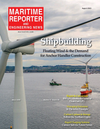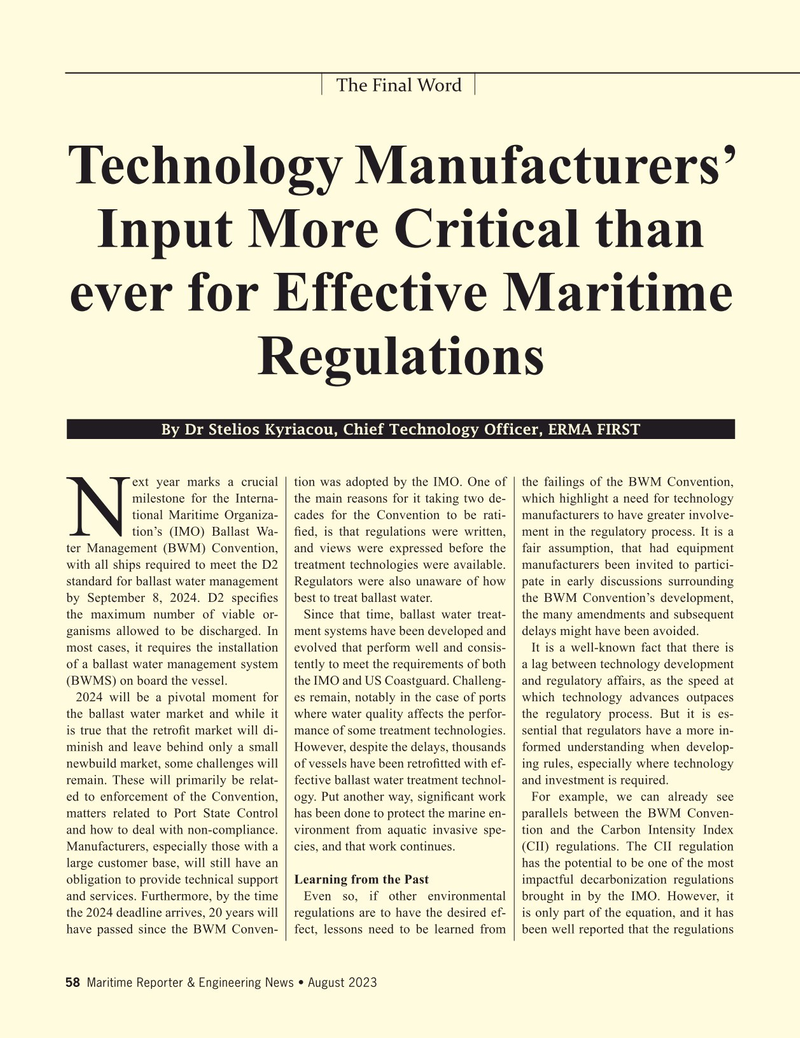
Page 58: of Maritime Reporter Magazine (August 2023)
Shipyard Annual
Read this page in Pdf, Flash or Html5 edition of August 2023 Maritime Reporter Magazine
The Final Word
Technology Manufacturers’
Input More Critical than ever for Effective Maritime
Regulations
By Dr Stelios Kyriacou, Chief Technology Officer, ERMA FIRST ext year marks a crucial tion was adopted by the IMO. One of the failings of the BWM Convention, milestone for the Interna- the main reasons for it taking two de- which highlight a need for technology tional Maritime Organiza- cades for the Convention to be rati- manufacturers to have greater involve-
N tion’s (IMO) Ballast Wa- ? ed, is that regulations were written, ment in the regulatory process. It is a ter Management (BWM) Convention, and views were expressed before the fair assumption, that had equipment with all ships required to meet the D2 treatment technologies were available. manufacturers been invited to partici- standard for ballast water management Regulators were also unaware of how pate in early discussions surrounding by September 8, 2024. D2 speci? es best to treat ballast water. the BWM Convention’s development, the maximum number of viable or- Since that time, ballast water treat- the many amendments and subsequent ganisms allowed to be discharged. In ment systems have been developed and delays might have been avoided.
most cases, it requires the installation evolved that perform well and consis- It is a well-known fact that there is of a ballast water management system tently to meet the requirements of both a lag between technology development (BWMS) on board the vessel. the IMO and US Coastguard. Challeng- and regulatory affairs, as the speed at 2024 will be a pivotal moment for es remain, notably in the case of ports which technology advances outpaces the ballast water market and while it where water quality affects the perfor- the regulatory process. But it is es- is true that the retro? t market will di- mance of some treatment technologies. sential that regulators have a more in- minish and leave behind only a small However, despite the delays, thousands formed understanding when develop- newbuild market, some challenges will of vessels have been retro? tted with ef- ing rules, especially where technology remain. These will primarily be relat- fective ballast water treatment technol- and investment is required. ed to enforcement of the Convention, ogy. Put another way, signi? cant work For example, we can already see matters related to Port State Control has been done to protect the marine en- parallels between the BWM Conven- and how to deal with non-compliance. vironment from aquatic invasive spe- tion and the Carbon Intensity Index
Manufacturers, especially those with a cies, and that work continues. (CII) regulations. The CII regulation large customer base, will still have an has the potential to be one of the most obligation to provide technical support Learning from the Past impactful decarbonization regulations and services. Furthermore, by the time Even so, if other environmental brought in by the IMO. However, it the 2024 deadline arrives, 20 years will regulations are to have the desired ef- is only part of the equation, and it has have passed since the BWM Conven- fect, lessons need to be learned from been well reported that the regulations 58 Maritime Reporter & Engineering News • August 2023
MR #8 (50-60).indd 58 8/3/2023 10:27:16 AM

 57
57

 59
59
